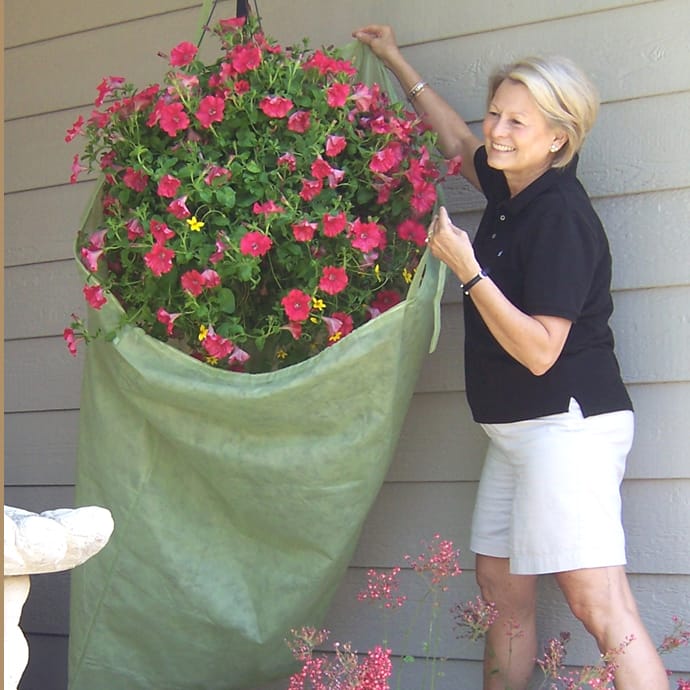Source(s):
- The LSU AgCenter, Louisiana State University.
- The North Carolina Cooperative Extension Service, North Carolina State University.
During the winter months it is sometimes necessary to protect certain landscape plants. Winter protection means providing protection to plants from freezing temperatures, damaging winds, heavy snow and ice, the alternate freezing and thawing of the soil beneath the plants, and heat from the sun on very cold days.
COLD TEMPERATURES
Small, individual plants can be protected by covering them with various-sized cardboard boxes, trash containers or other such structures. Larger plants can be protected by constructing a simple frame over the plant and covering the frame with sheets, quilts or plastic. The frame holds the covering off the foliage preventing branch breakage and improving cold protection. A frame need be nothing more elaborate than three or four stakes slightly taller than the plant, driven into the ground. The cover should extend to the ground and be sealed with soil, stones or bricks. Plastic covers should be vented or removed on sunny, warm days.
Plant covers will work best for light freezes by preventing or blocking heat loss. The extreme, prolonged cold that occurs during severe freezes is not so easily dealt with. Many plants will still die even with protection. This can be helped by providing a heat source under the covering. A safe, easy way to do this is to wrap or drape the plant with small outdoor Christmas lights. The lights provide heat but do not get hot enough to burn the plant or cover. Be careful and use only outdoor extension cords and sockets.
WATER LOSS
Protection should be offered to evergreen plants by reducing water loss. Plants transpire water through their leaves. Evergreen plants continue to lose water during the winter, therefore, adequate moisture must be taken up by an evergreen plants’ roots during this season. Homeowners are more conscious of watering shrubs during the summer months and often this garden chore is neglected during cold weather.
An evergreen plants’ roots will absorb moisture when it is available, but when the ground is frozen, adequate moisture may not be available. Evergreen plants continue to transpire water, drawing moisture from living plant cells. If too much water is derived from this source, the leaves and stems dry out and die.
WIND PROTECTION
High winds and a warm sun on cold days result in a higher rate of water transpiration. Protection could be offered by planting susceptible plants in sheltered locations and providing additional water and coverings during expected periods of high winds and cold temperatures.
MULCHES
Sufficient layers of mulch material is always recommended during winter months after the first freeze. Mulches reduce water loss from the soil, thus helping to prevent drying of plant tissues. Mulches also reduce ‘heaving’ of the soil as the soil freezes and thaws.
To protect plants from cold damage, the following 6 steps are suggested:
- Plant only varieties that are hardy to your area.
- If you have a choice, locate less hardy plants in the highest part of the yard. Cold air settles to the lowest part of the yard.
- Protect sensitive plants from cold winds. A fence or tall evergreen hedge of trees or shrubs gives good protection.
- Shade plants from direct winter sun, especially early morning sun. Plants that freeze slowly and thaw slowly will be damaged the least. Obviously, the south side of the house with no shade is the worse place for tender plants.
- Stop feeding plants quickly-available nitrogen in late summer. Let them “harden off” before cold weather.
- A covering of plastic is excellent protection. Build a frame over the plant or plants, cover with plastic and seal plastic to the ground with soil. Shade plastic to keep temperature from building up inside. This plastic traps moisture and warm air as it radiates from the soil. It also knocks off cold wind. Be certain not to allow plastic to come in contact with plants.
Resource(s): Winter Protection of Ornamental Plants
Center Publication Number: 247
- Common Tomato Problems - May 9, 2018
- Growing Tomatoes - September 24, 2013
- Japanese Hollies - September 24, 2013
